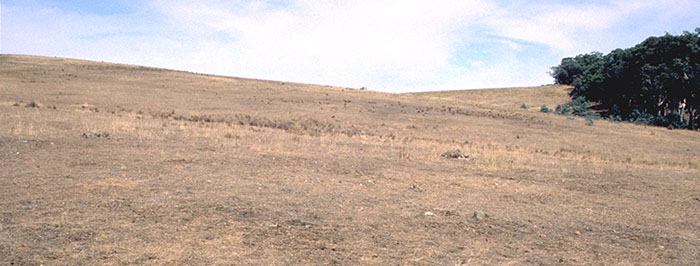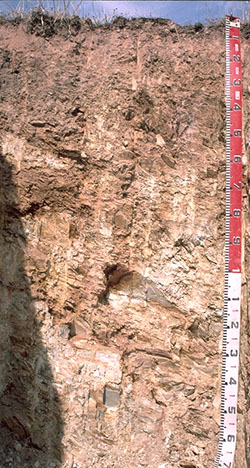LP106
Australian Soil Classification: Magnesic Mesonatric Brown SODOSOL (moderately gravelly surface)
Northocte Factual Key: Db 1.23
Great Soil Group: No suitable group
Site Description: Footslope of sedimentary hill.
Geology: Sandstone/siltstone (Ordovician).

Soil Profile Morphology
Surface Soil
| A1 | 0-5 cm | Dark brown (7.5YR3/4); sandy loam; weak medium blocky structure; very firm consistence dry; many fine siltstone gravels; pH 5.8; abrupt and wavy change to: |  LP106 Profile |
| A2 | 5-20 cm | Reddish brown (2.5YR5/4), conspicuously bleached pink (10YR7/3); sandy loam;massive structure; strong consistence dry; many fine siltstone gravels ; pH 6.8; abrupt and wavy change to: | |
| Subsoil | |||
| B2 | 20-30 cm | Dark yellowish brown (10YR3/6); sandy clay; massive; strong consistence dry; abundant medium sized siltstone gravels ; pH 8.6; gradual and wavy change to: | |
| B/C | 30-60 cm | Strong brown (7.5YR5/6); medium heavy clay; 70% weathering siltstone; strong very fine blocky structure; very strong consistence dry; pH 9.7; diffuse change to: | |
| C | 60+ cm | Weathering siltstone. | |
Key Profile Features
- Strong texture contrast between surface (A) and the top subsoil (B21) horizon.
- High content of alluvial gravel in the surface horizons.
- 70% rock (siltstone) at 30 cm becoming 100% at 60 cm
Key Profile Characteristics
pH | Salinity Rating | |||
Surface (A1 horizon) | Moderately Acidic | Medium | Strongly Sodic | Moderately Dispersive1 |
Subsoil (B21 horizon) | Strongly Alkaline | Low | Strongly Sodic | Strongly Dispersive |
Deeper subsoil (60 cm) | Extremely Alkaline | Low | Strongly Sodic | Strongly Dispersive |

| The surface is moderately acid. The subsoil is alkaline. | The salinity rating in the surface is medium, and low in the subsoil.
| This profile is strongly sodic. | Low clay content in the surface, with a sharp increase at the A/B interface. |
Horizon | Horizon Depth (cm) | pH (water) | pH (CaCl2) | EC dS/m | Organic Carbon % | Exchangeable Cations | Coarse Sand (0.2-2.0 mm) % | Fine Sand (0.02-0.2 mm) % | Silt (0.002-0.02 mm) % | Clay (<0.002 mm) % | Wilting Point % w/w | |||
Ca | Mg | K | Na | |||||||||||
meq/100g | ||||||||||||||
A1 | 0-5 | 5.8 | 4.7 | 0.13 | 4.8 | 2.7 | 3.8 | 0.52 | 1.3 | 18 | 33 | 22 | 24 | 11.4 |
A2 | 5-20 | 6.8 | 5.0 | 0.05 | 1.1 | 3.4 | 0.19 | 0.97 | ||||||
B21 | 20-30 | 8.6 | 7.1 | 0.10 | 1.4 | 9.3 | 0.39 | 1.9 | 6 | 18 | 51 | 51 | 16.2 | |
B22 | 30-60 | 9.7 | 7.9 | 0.44 | 0.58 | 12 | 0.59 | 6.3 | ||||||
| Management Considerations: Whole Profile
Surface (A) Horizons
Subsoil (B) Horizons
Profile Described By: Mark Imhof, Paul Rampant and Karen DePlater, November 1995 |


